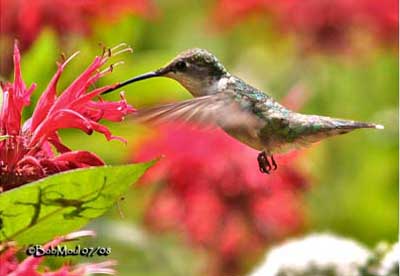

FAMILY TROCHILIDAE
HUMMINGBIRDS
The Family Trochilidae gathers more than 300 species of Hummingbirds, and it is one of the largest families of the New World.
Hummingbirds usually are very small birds of only some grams, but these birds are unique by their flight, their behaviour, and their ability to enter hypothermic torpor in order to conserve the energy during the night.
They are the perfect example showing that size is not very important in wild. The main goal is to survive and Hummingbirds, in spite of habitat loss in several areas, are a very strong bird species.
Hummingbirds belong to the Order Apodiforme and the Family Trochilidae. In this family, we find two subspecies, the Trochilinae (Hummingbirds) and the Phaethornithinae (Hermits).
Hummingbirds are small birds. The long, thin bill may have different shapes, according to the feeding behaviour. Their specialized and sensitive tongue allows them to reach the nectar which is their preferred food.
Hummingbirds are loved by humans. These beautiful birds are admired for their beauty and interesting behaviour, closely related to brightly coloured flowers. For humans, Hummingbirds are mysterious birds!
Trochilid feathers were used by native South American people in their adornments, and we know that they always have done, but today, killing for feathers belongs to the past. Hummingbirds are symbols of peace, love and happiness, considered as sacred birds for their unbelievable energy.
Photographers:
Patrick Ingremeau: TAMANDUA
Tom Grey: Tom Grey's Bird Pictures
Tom Merigan: Tom Merigan’s Photo Galleries
Bob Moul: Nature Photography
Text by Nicole Bouglouan
Sources:
HANDBOOK OF THE BIRDS OF THE WORLD Vol 5 by Josep del Hoyo-Andrew Elliott-Jordi Sargatal - Lynx Edicions - ISBN: 8487334253
Animal Diversity Web (University of Michigan Museum of Zoology)
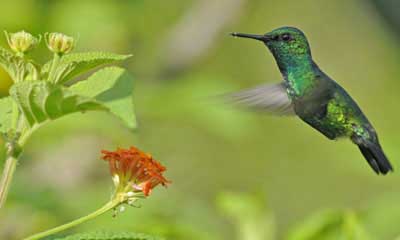
They have very short legs and they are unable to walk or hop on the ground. But their wings are very well adapted to the hovering, necessary for feeding. Hummingbirds are very agile in flight. When feeding on nectar, the bird is able to hover forwards and backwards. The wings draw flattened “8”, and the wingbeat rate ranges from 70-80 per second in the smallest Trochilids, to 10-15 per second in the Giant Hummingbird.
The wingbeat rate may reach up to 200 per second during the courtship flights of some North American Hummingbirds such as the Ruby-throated Hummingbird and the Rufous Hummingbird. These wingbeats produce a humming sound, giving the birds their English name.
Such flight and wing movements need energy. According to the air temperature, the wingbeat frequency changes, allowing the Hummingbird to achieve the energy conservation.
Energy is also a problem for these small birds during the cold nights. Hummingbirds save the energy by entering hypothermic torpor, a state very close to hibernation in other animal species. In appearance, the bird seems to be dead.
But during the day, these perfect small birds display their wonderful plumages when feeding among flowers.
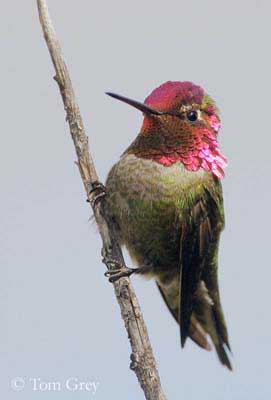
Hummingbirds have iridescent feathers, often on head and throat, but other parts of the body may have glossy feathers. These shiny feathers are strongly exposed during the displays. According to the light, the feathers may appear metallic golden, green, blue, red… or quite dull!
The plumage coloration is closely related to the behaviour. Females always are duller than males, and exhibit more cryptic colours, very useful at nest-site.
Hummingbirds use their beautiful glossy plumage in several situations such as courtship, territorial defence and threat behaviour against rivals or intruders. These displays are accompanied by a wide vocal repertoire and other sounds produced by the rapid wingbeats.
The voice of these active birds is often heard before to see the hummingbird. The most common sounds are high-pitched monosyllabic chirps and whistles. The very short calls are uttered by both sexes when feeding, or from exposed perches. These calls are given when territorial birds are feeding at rich food sources. The chase calls are aggressive rapid chattering given in series. But each species utters different sounds, shorter, longer, higher-pitched or lower. The repertoire is very large and allows good field identification.
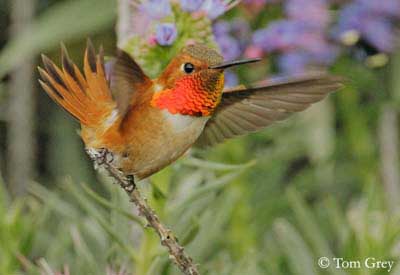
Hummingbirds strongly defend their food sources. Their preferred food plants bear fairly large flowers, solitary or in clusters, in horizontal or pendent position. These flowers are opened by day and are usually brightly coloured, yellow, red or orange.
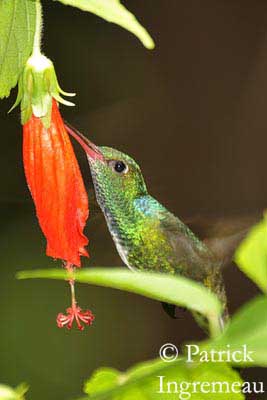
Hummingbirds play an important role in pollinisation, even some species such as the Blue-tailed Emerald or the Glittering-throated Emerald perform “nectar-robbing”, taking the nectar by piercing at flower base. According to the bill size, the birds take the nectar into flowers with more or less long corollas.
In Trochilidae, males are polygamous and mate with several females. They do not take part to nesting duties. The female builds the nest, incubates her eggs and rears the young alone.
The courtship displays by male include songs, exposition of the iridescent plumage and flight displays at leks. This behaviour for attracting females is similar to the defence displays.
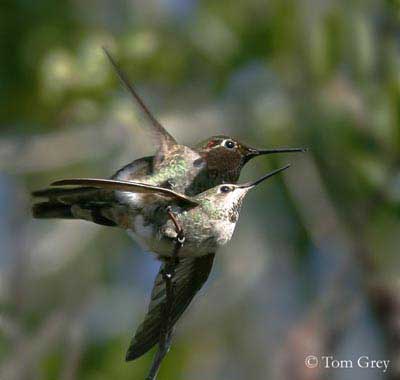
After mating, the female selects the nest-site, often near a rich nectar source. The tiny nest is often situated in branches with leaves or palms to which she attaches the nest, or glued to rocky walls, hidden among vegetation and even fastened beneath a hanging leaf which shelters the nest from the rain.
The small nest is cup-shaped, and may be domed or semi-domed. The exterior is decorated with lichens, moss, leaves and pieces of bark providing an excellent camouflage. Spider webs are often added for binding together all the materials. The interior is lined with soft, finer plant materials, feathers or animal hair.
The female needs several days to build such nest, and she repairs it regularly during the nesting period.
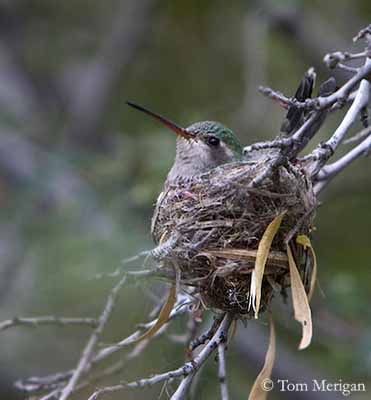
She usually lays two white eggs. Incubation lasts between 16 and 19 days, and may vary from 14-16 to 22-23 days, according to the species.
The altricial chicks hatch almost naked and blind. The nesting period lasts 23 to 26 days (up to 30-40 days in high Andean Trochilids). The female feeds them by regurgitation into their mouths. This food consists of nectar and small insects. She feeds the chicks throughout the day, usually twice per hour.
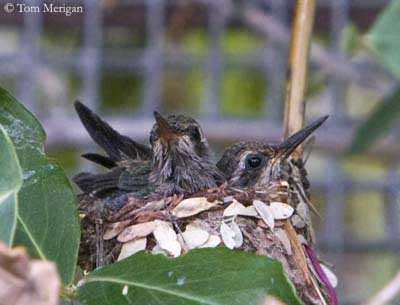
She broods them the first 7-12 days. Chicks grow quickly and become active in the nest. At 15-18 days of age, they preen their plumage and look around the nest.
They leave the nest some days later, and female feeds them during three or four weeks more. Then, the young learn from their mother how to feed themselves and to find rich food sources.
The female hummingbird may rear two broods per season. For the tiny tropical species such as Chaetocercus and Lophornis, only one brood is observed, for energetic reasons.
Hummingbirds are resident in their range, only performing some short-distance movements according to the food resources. Altitudinal movements and post-breeding dispersal may be observed, but always related to nectar availability.
However, some species may perform true migration of about 1000 km long.
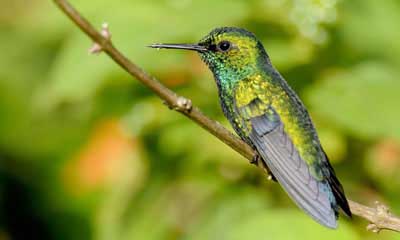
Hummingbirds do not suffer special threats directed at them, but like numerous birds’ species, they are threatened by habitat loss, deforestation, pesticides, bad weather, forest fires and residential developments.
On the other hand, they can find huge numbers of feeders and specific flowers in private gardens that explain their presence in urban areas.
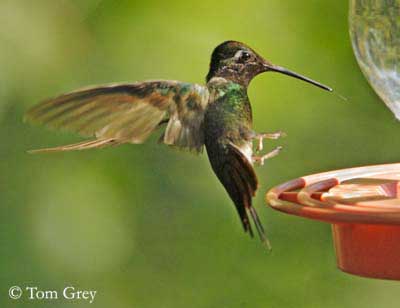
They are found only in the New World, from Alaska to Labrador in North, to Tierra del Fuego in South. Most of the species are tropical and sub-tropical, and are living in Brazil and Ecuador.
